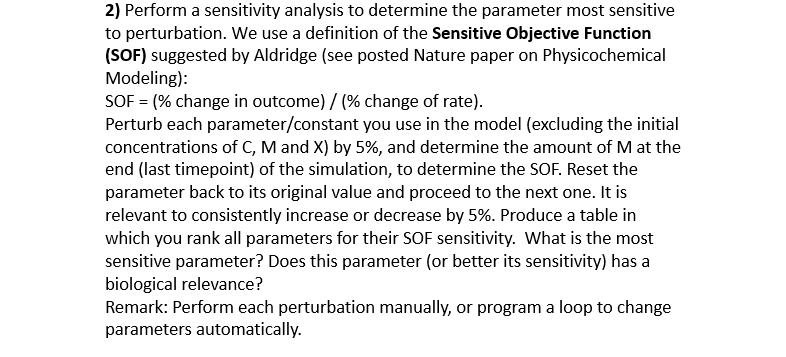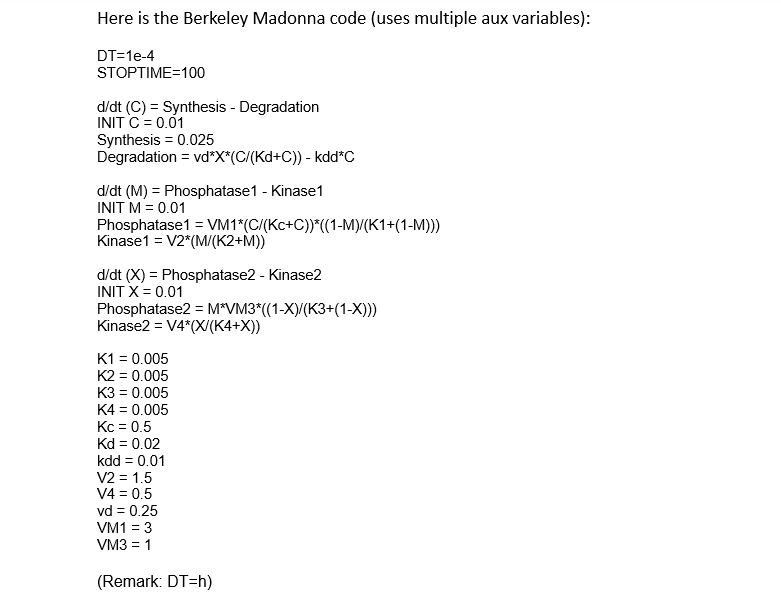Question
Use Matlab for all questions, include graphs and comment what you did and address all questions. Upload your m-files with your submission. In this portion


 Use Matlab for all questions, include graphs and comment what you did and address all questions. Upload your m-files with your submission. In this portion of the homework you will reproduce the minimalistic cell cycle model of Goldbeter, published in PNAS in 1992, a publication posted under the Resources folder. Perform a sensitivity analysis to determine the parameter most sensitive to perturbation. We use a definition of the Sensitive Objective Function (SOF) suggested by Aldridge (see posted Nature paper on Physicochemical Modeling): SOF = (% change in outcome) / (% change of rate). Perturb each parameter/constant you use in the model (excluding the initial concentrations of C, M and X) by 5%, and determine the amount of M at the end (last timepoint) of the simulation, to determine the SOF. Reset the parameter back to its original value and proceed to the next one. It is relevant to consistently increase or decrease by 5%. Produce a table in which you rank all parameters for their SOF sensitivity. What is the most sensitive parameter? Does this parameter (or better its sensitivity) has a biological relevance? Remark: Perform each perturbation manually, or program a loop to change parameters automatically.
Use Matlab for all questions, include graphs and comment what you did and address all questions. Upload your m-files with your submission. In this portion of the homework you will reproduce the minimalistic cell cycle model of Goldbeter, published in PNAS in 1992, a publication posted under the Resources folder. Perform a sensitivity analysis to determine the parameter most sensitive to perturbation. We use a definition of the Sensitive Objective Function (SOF) suggested by Aldridge (see posted Nature paper on Physicochemical Modeling): SOF = (% change in outcome) / (% change of rate). Perturb each parameter/constant you use in the model (excluding the initial concentrations of C, M and X) by 5%, and determine the amount of M at the end (last timepoint) of the simulation, to determine the SOF. Reset the parameter back to its original value and proceed to the next one. It is relevant to consistently increase or decrease by 5%. Produce a table in which you rank all parameters for their SOF sensitivity. What is the most sensitive parameter? Does this parameter (or better its sensitivity) has a biological relevance? Remark: Perform each perturbation manually, or program a loop to change parameters automatically.
Please help!! Thank you in advance
Use Matlab for all questions, include graphs and comment what you did and address all questions. Upload your m-files with your submission. In this portion of the homework you will reproduce the minimalistic cell cycle model of Goldbeter, published in PNAS in 1992, a publication posted under the "Resources" folder. 2) Perform a sensitivity analysis to determine the parameter most sensitive to perturbation. We use a definition of the Sensitive Objective Function (SOF) suggested by Aldridge (see posted Nature paper on Physicochemical Modeling): SOF = ( % change in outcome )/(% change of rate ). Perturb each parameter/constant you use in the model (excluding the initial concentrations of C,M and X ) by 5%, and determine the amount of M at the end (last timepoint) of the simulation, to determine the SOF. Reset the parameter back to its original value and proceed to the next one. It is relevant to consistently increase or decrease by 5%. Produce a table in which you rank all parameters for their SOF sensitivity. What is the most sensitive parameter? Does this parameter (or better its sensitivity) has a biological relevance? Remark: Perform each perturbation manually, or program a loop to change parameters automatically. Here is the Berkeley Madonna code (uses multiple aux variables): DT=1e4 STOPTIME =100 d/dt(C)= Synthesis - Degradation INIT C =0.01 Synthesis =0.025 Degradation =vdX(C/(Kd+C))kddC d/dt(M)= Phosphatase 1 Kinase 1 INIT M=0.01 Phosphatase1 =VM1(C/(KC+C))((1M)/(K1+(1M))) Kinase 1=V2(M/(K2+M)) d/dt(X)= Phosphatase 2 - Kinase 2 INIT X=0.01 Phosphatase2 =MVM3((1X)/(K3+(1X))) Kinase 2=V4(X/(K4+X)) K1=0.005 K2=0.005 K3=0.005 K4=0.005 Kc=0.5 Kd=0.02 kdd=0.01 V2=1.5 V4 =0.5 vd=0.25 VM1 =3 VM3 =1 (Remark: DT=h)Step by Step Solution
There are 3 Steps involved in it
Step: 1

Get Instant Access to Expert-Tailored Solutions
See step-by-step solutions with expert insights and AI powered tools for academic success
Step: 2

Step: 3

Ace Your Homework with AI
Get the answers you need in no time with our AI-driven, step-by-step assistance
Get Started


